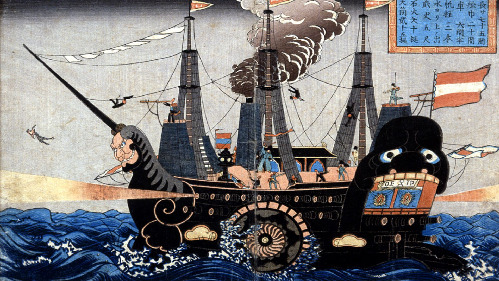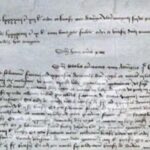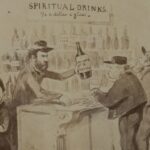1. Blue-Eyed Samurai
It has been a common belief that the first person to bring whisky to Japan was a blue-eyed samurai named William Adams (Anjin Miura).
In recent years, however, as research on whisky and historical research has progressed, various questions have arisen.
Here, we would like to unravel the previously established theory of Anjin Miura, as well as a new theory proposed by Mamoru Tsuchiya, president of the Whisky Culture Research Institute, in his book “Japanese Whisky as a Cultivation Effective for Business”.
1-1 William Adams
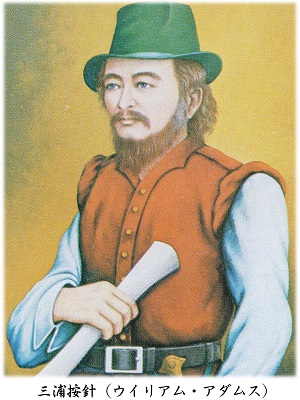
Image Source: Official Website of Usuki City, Oita Prefecture
William Adams, aka Anjin Miura, was born in Gillingham, Kent, southeast England.
Interested in navigation from an early age, he joined the Royal Navy at the age of 24.
He married the following year, had two children, and left the military to work as a captain in a London trading company.
One day, he heard from Dutch sailors that they were looking for an experienced navigator for a voyage from Rotterdam to the Far East, and he volunteered.
On this voyage, only one of the five ships made it to the Far East.
Two ships were captured by Portugal and Spain, and one was lost.
The other ship sank, and William found himself with only the Liefde on board…
The number of sailors on board had dropped from 110 to 24.
After drifting ashore on Kuroshima Island in Oita Prefecture, William was taken into custody and granted an audience with Tokugawa Ieyasu.
It is believed that he may have offered Ieyasu a bottle of whisky during this audience.
Ieyasu was pleased with William’s efforts in diplomacy and shipbuilding, and in recognition of his achievements, Ieyasu allowed him to wear a sword and gave him the name Anjin Miura.
Unfortunately, he was never able to set foot on the soil of his hometown, but he was blessed with two children.
1-2 Japanese who traveled to England and abroad at that time in 1598
At the time William left England, it was before the “Personal Union” of Scotland and England under the same monarch.
Whisky was a local product of Scotland, so it was never distributed in England.
Some people say that it is unlikely that William, an Englishman, drank whisky, and that it is unlikely that he brought whisky, which he had never drunk, from Scotland to the Netherlands, loaded it on a ship, and presented it to Tokugawa Ieyasu when he had an audience with Tokugawa.
What about the theory that Japanese people went abroad or drifted ashore and drank or brought whisky with them?
There were two men, “Daikokuya Kodayu” and “John Manjiro”, both of whom wrote in their memoirs.
Both of them left their memoirs, but unfortunately, there is no mention of whisky in them.
If so, who can clearly be said to have been the first to bring whisky to Japan in the existing literature?
2. Perry’s visit to Japan
2-1 Departure of the Mississippi
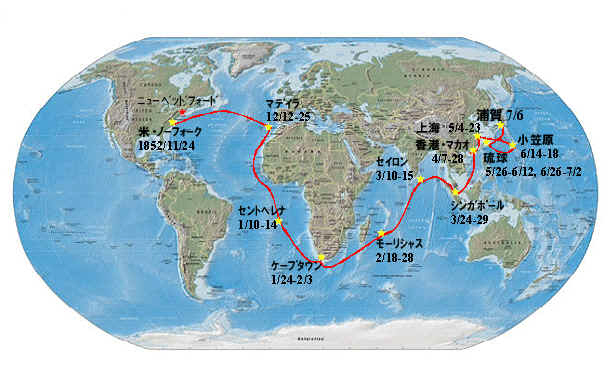
Black Ships Route Image Source: Geographic Information Center of the Americas
In November 1852, Perry, commander of the East India Squadron, departed the U.S. port of Norfolk aboard the Mississippi, a steam warship he had helped build.
He crossed the Atlantic Ocean and entered the Indian Ocean via Madeira Island, St. Helena Island, and Cape Town, then rounded three-quarters of the globe via Mauritius, Singapore, Hong Kong, and Shanghai, arriving at Okinawa on May 26, 1853, to build a necessary coal depot and to supply American ships and whalers with supplies. Perry arrived in Okinawa.
Immediately, Perry insisted on a visit to Shuri Castle.
He wanted to bring his troops into the royal castle and use force to gain an advantage in future negotiations.
He had experience negotiating in China before coming to the Kingdom of Ryukyu.
It seems that Perry had the same intention toward the Japanese as he had toward the Chinese, saying, “Appealing to fear may have more advantages than appealing to friendship”.
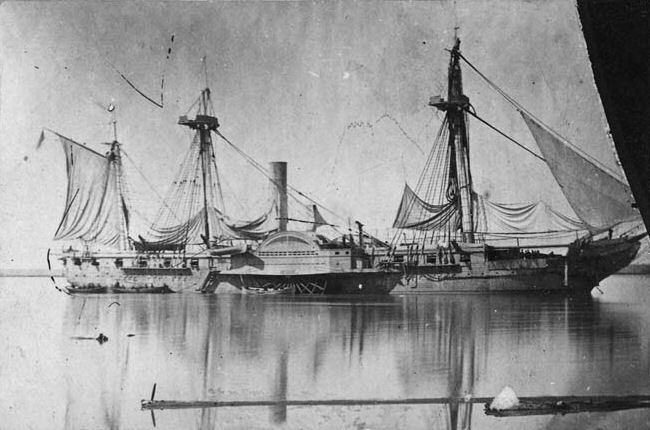
The Mississippi (image source: wikipedia)
2-2 Tension in the Ryukyu Islands
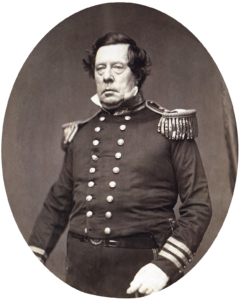
Matthew Calbraith Perry (image source: wikipedia)
Although the royal government refused to allow Perry to visit Shuri Castle, Perry announced that he would pay a courtesy visit to Shuri Castle on June 6, 10 days after his arrival at the port.
On the 6th, Perry visited Shuri Castle with about 200 officers, and was forced to open the gates.
In fact, however, the Ryukyuans had set up a false administrative body to avoid direct contact with the top officials and the royal family.
In addition, the king’s main palace was covered with cloth to hide the king’s presence, and fake officials held a ceremony to welcome guests in the north palace, which was used as a guest house, to cover the occasion.
Although they could not prevent the foreigners from visiting Shuri Castle, which they had not allowed in the past, they protected the most important place in Shuri Castle, Seiden, as well as the King of Ryukyu and the officials in the central part of the castle.
Afterwards, the regent of the Ryukyu Kingdom, Shan Han Hyun, invited the king to his home in the castle and held a banquet.
The banquet was described in the “Chronicle of Commodore Perry’s Japanese Expedition.”
“Chopsticks were placed on each table, and in the center was a clay pot filled with sake. (omission) Probably a pig. It was red-colored and thinly chopped boiled eggs, fish rolled up and fried in oil, cold grilled fish fillets, slices of pork liver, sugar candy, cucumbers, mustard, salted radish leaves, and fried shredded lean pork, all of which Westerners would recognize. First tea was served, then sake (awamori), which tasted of French liqueur, was poured into very small cups.”
This is how it is described in detail.
Perry’s group was apparently pleased with the Ryukyuan hospitality, saying, “In general, the food was good and very tasty, even better than the Chinese food.”
Having accomplished his initial goal of visiting the royal palace, Perry returned to Ryukyu after surveying the Ogasawara Islands, and this time on June 28, Perry entertained the Ryukyuan dignitaries on board his ship.
In addition to sea turtle soup and goat meat, wine, sherry, gin, whisky, and other alcoholic beverages from around the world were served.
The “first drinkers of whisky in Japan” were the dignitaries of the Ryukyu Kingdom.
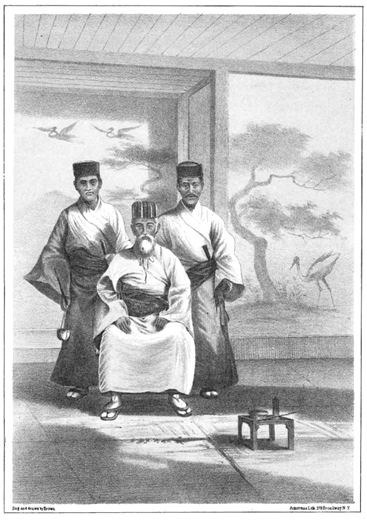
Written by the attendant Shan Han Hyun Image source: Rekishi Magazine
2-3 Black Ships Arrive in Japan
Leaving some of his ships in Ryukyu, Perry sets sail. The destination is Uraga Bay.
The purpose of the voyage is to fulfill Commodore Perry’s ultimate goal of opening Japan to the outside world.
On July 8, 1853, Perry arrived in Uraga Bay and asked to receive a letter from U.S. President Fillmore to the Shogun.
The Japanese, on the other hand, refused to receive the letter at Uraga, having learned of the arrival of the black ships through trade with the Netherlands last year, and requested that the letter be sent to Nagasaki.
In response, Perry rejected the Japanese request in a very strong manner, as he had done in negotiations with China and the Ryukyu Kingdom, and asked to receive the documents at Uraga.
Eizaemon Kayama, a yoriki of the Uraga Magistrate’s Office, was in charge of the negotiations.
It is said that Perry wanted to negotiate with a man of higher rank, but Eizaemon knew that he would not be taken seriously because he was a yoriki, so he pretended to be a magistrate to conduct the negotiations.
The Japanese side, however, settled on the idea of establishing a reception hall in Uraga for the receipt of letters of intent from Perry, who consistently maintained a strong attitude, and having a person of appropriate rank receive the letters.
On July 12, Perry served whiskey on board the Susquehanna to celebrate the decision to receive the letter at Uraga. On the Japanese side were Eizaemon Kayama, interpreter Tatsunosuke Hori, and Tokujuro Tateishi, while on the American side were Commander Franklin Buchanan, captain of the Susquehanna; Commander Henry A. Adams, chief of the fleet staff; Captain Conti, flag officer, with interpreters Williams and Portman.
The scene at this time was.
“Eizaemon Kayama and his crew were in a very good mood and gladly accepted the hospitality offered by the officers of the Susquehanna.
They drank and ate freely when receiving the hospitality of their masters, and they especially liked the whisky and brandy that formed part of the feast.
Among these, the magistrate’s favorite seemed to be foreign-made liqueurs, especially those mixed with sugar, and he drank every drop of the luscious liquor while smacking his lips loudly.
The interpreters gradually became more at home at the pleasant banquet, teasing the drunken magistrate, laughing and saying, ‘Your face is already bright red,’ and warning Eizaemon not to drink too much.
These Japanese dignitaries never lost their gentlemanly demeanor and refined appearance, which spoke of their high culture, but they remained sociable and conversed openly with each other.
Their knowledge and general information were as good as their elegant and amiable manners.
They were not only well groomed but also well educated, fluent in Dutch, Chinese, and Japanese, and not ignorant of the general principles of science and the facts of world geography.
He held a globe in front of him, drew his attention to a map of the United States, and immediately pointed to Washington and New York.
As if they knew all there was to know about the fact that one was the capital of our country and the other the center of commerce.
They were equally quick to point to England, France, Denmark, and other European kingdoms.” (Perry’s Fleet Expedition to Japan, supra p. 545-546)

Perry as depicted in a Japanese print, circa 1854 (image source: wikipedia)
After this, Eizaemon Kayama was highly praised by Perry for his brilliant behavior, and he had several meals with Perry.
Eizaemon was so trusted by Perry that Perry asked him to be his point of contact when he returned to Japan.
Two days later, on July 14 of the same year, Eizaemon landed at Kurihama, which was designated by the shogunate, and handed a letter of invitation from President Fillmore to Uragah Magistrate Toda Ujiyoshi and Ido Hiromichi, also a Uraga Magistrate.
After surveying the bay for a few days, the Shogunate asked him to wait until the following year, and he said he would wait until next spring for food and other fleet needs.
About six months later, on February 8, 1854, Perry’s fleet arrived again.
The Shogunate and Perry’s fleet held negotiations over a meeting place to conclude a treaty of friendship between Japan and the United States, and on February 25, they decided to establish a reception hall in Yokohama to begin negotiations.
The Yokohama reception hall was completed on March 6, and Perry’s fleet landed there on March 8.
After nearly a month of negotiations, a draft treaty was finalized.
On March 27, before the signing of the treaty on March 31, a drinking party was held on the flagship Pawhatan at Perry’s invitation.
At this time, the American archivist wrote:
“The Japanese officials were particularly fond of John Barleycorn, who stuffed a ham into the bosom of his kimono and came off the ship with a drunken, red face.”
The following year, on March 31, 1854, the Japan-US Treaty of Peace and Amity was signed, and the sounds of civilization and enlightenment began to be heard.
3. Discussion of Whisky Brought by Perry
It is said that Perry brought Scotch whisky and American rye whisky.
However, the brand name of the whisky is not clearly known, but there is a discussion in Tsuchiya’s book, which I would like to introduce.
Tsuchiya says that the Scotch brought by Perry was “Smith’s Glenlivet” mentioned in Chapter 1.
The reason for this is that in 1852, when Perry sailed from Norfolk Military Port, there was no blended whisky made by mixing malt whisky and grain whisky.
Blended whisky was not produced until 1860.
Then, how could Perry of the United States bring Scotch, the local liquor of Scotland?
3-1 Jardine Matheson Trading Company
Founded in 1832 by Scotsmen Williams Jardine and James Matheson, the trading company made large profits from the purchase of tea and raw silk and the opium smuggling trade, and had branches in Hong Kong as well as in Shanghai and other Asian countries.
Thomas Glover, famous for the Glover House in Nagasaki, was an employee of this company.
It is highly likely that the Jardine Matheson Trading Company, which also had branches in Hong Kong, probably distributed scotch to all of its branches.
It is highly possible that Perry purchased “Smith’s Glenlivet,” which was very popular in Scotland at the time, at this time during his stay in Hong Kong when he was on his way to Japan, when he could obtain scotch.
Jardine Matheson & Co. still has its headquarters in Hong Kong, and is ranked 301st in the world in the “Fortune Global 500” (2020 edition), a ranking of the top 500 companies in the world.
Even 190 years after its founding, it remains influential as one of the world’s largest international conglomerates based in Asia.
3-2 Independent Whisky
What was the next brand of American whisky that Perry brought with him?
The United States is known for bourbon, but the main production areas, Kentucky and Tennessee, did not yet produce enough at that time, so it is unlikely that it was loaded on Perry’s ship.
The Norfolk military port from which Perry’s ship, the Mississippi, departed was in Virginia, and the whisky produced in Virginia was similar to today’s rye whisky.
Perhaps Perry loaded that rye whisky on board. 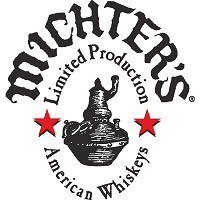
Another possibility is that it may have been “Michter’s“, a whisky founded in 1753 that the first U.S. president, George Washington, drank to keep warm with his soldiers at the Valley Forge base when he was a general in the Revolutionary War.
“Independence Day” has always been a special day for the United States, and if it was George Washington’s favorite whisky, there is no doubt that Commodore Perry may have loaded it on his ship.
3-3 John Barleycorn
In the last entry of Perry’s journal, he wrote that the “Japanese officials were very fond of John Burleycorn….”
John Barleycorn is a character in an English folk song and the title of the song.
It personifies barley, an important grain, and beer and whisky, the alcoholic beverages made from it.
The lyrics of the song describe how the barley is planted, harvested, and turned into an alcoholic beverage, and there are many different versions of the song, including beer, whisky, and for some reason brandy versions, which are still sung by famous musicians today.
There were three men come out of the west
Their fortunes for to try,
And these three men made a solemn vow:
John Barleycorn should die.
They ploughed, they sowed, they harrowed him in,
Throwned clods upon his head.
And these three men made a solemn vow:
John Barleycorn was dead.They let him lie for a very long time
Till the rain from heaven did fall,
And little Sir John sprung up his head
And so amazed them all.
They let him stand till midsummer’s Day
And he grew both pale and wan.
Then little Sir John, he grewed a long beard
And so become a man.They hired men with the scythes so sharp
To cut him off at the knee
And poor little Johnny Barleycorn
They served most barbarously.
They hired men with the sharp pitchforks
To pierce him to the heart
And the loader, he served him worse than that
For he bound him to the cart.They wheeled him all around the field
A prisoner to endure,
And in the barn poor Barleycorn
They laid him upon the floor.
They hired men with the crab tree sticks
To cut his skin from bone
And the miller, he served him worse than that
For he ground him between two stones.Here’s little Sir John in the nut-brown bowl
And here’s whisky in the glass
And little Sir John in the nut-brown bowl
Proved the strongest man at last
For the huntsman, he can’t hunt the fox
Nor so loudly to blow his horn
And the tinker, he can’t mend kettles nor pots
Without a little barley corn.
In these lyrics, he sings that he can’t work or do anything without whisky.
It is truly the song of a whisky lover.
~The History of Whisky in Japan~
https://en.jpwhisky.net/history-2/whiskeyhistory1-2/
https://en.jpwhisky.net/history-2/history-whiskeyhistory2-2/
https://en.jpwhisky.net/history-2/history-whiskeyhistory3-2/
[box type=”note” align=”” class=”” width=””]
Chapter 4: Shinjiro Torii
Recently released[/box]
[box type=”note” align=”” class=”” width=””]
Chapter 5: Kiichiro Iwai
Recently released[/box]
[box type=”note” align=”” class=”” width=””]
Chapter 6: Masataka Takesuru
Recently published[/box]
[box type=”note” align=”” class=”” width=””]
Chapter 7: Before and after the battle
Recently published[/box]
[box type=”note” align=”” class=”” width=””]
Chapter 8: High growth period – Now
Recently published[/box]

